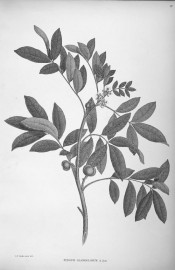Synoum glandulosum (Sm.) Juss.
Frost tender evergreen shrub or small tree with pinnate leaves composed of up to 7 elliptical-lance-shaped leaflets, and reddish-white flowers most of the year. To 7m. [FNSW, Beadle].
Horticultural & Botanical History
‘The specimens on which Smith’s description was founded were sent to him by Banks under Solander’s MS. name T. octandra, ‘“which not being published we presume to change, as the octandrous species of the genus are numerous, though this only was then known to the great botanists who first discovered it” (Rees Cyclop., l.c.). Banks’s specimens, which are not referred to by Bentham, are from Botany Bay’. [Solander & Banks – Illustrations of the Botany of Captain Cook’s Voyage vol.1, p.15, pl.37/1900].
Introduced to Britain by Sir Abraham Hume, from material provided by Dr. Anderson from the St. Vincents Botanic Garden [ABR pl.637/1814]. How the species arrived in the West Indies before England is unclear.
History at Camden Park
Listed only in the 1857 catalogue [T.974/1857] but widespread on the coast and adjacent ranges in warmer rainforest in the Sydney region and probably locally sourced.
Notes
Published Mar 21, 2009 - 05:01 PM | Last updated Mar 24, 2010 - 02:58 PM

Synoum glandulosum (Sm.) Juss. | Solander & Banks – Illustrations of the Botany of Captain Cook’s Voyage vol.1, pl.37/1900 | BHL
| Family | Meliaceae |
|---|---|
| Category | |
| Region of origin | Eastern Australia |
| Synonyms |
|
| Common Name | Bastard rosewood, Scentless rosewood |
| Name in the Camden Park Record | Trichilia glandulosa |
| Confidence level | high |

